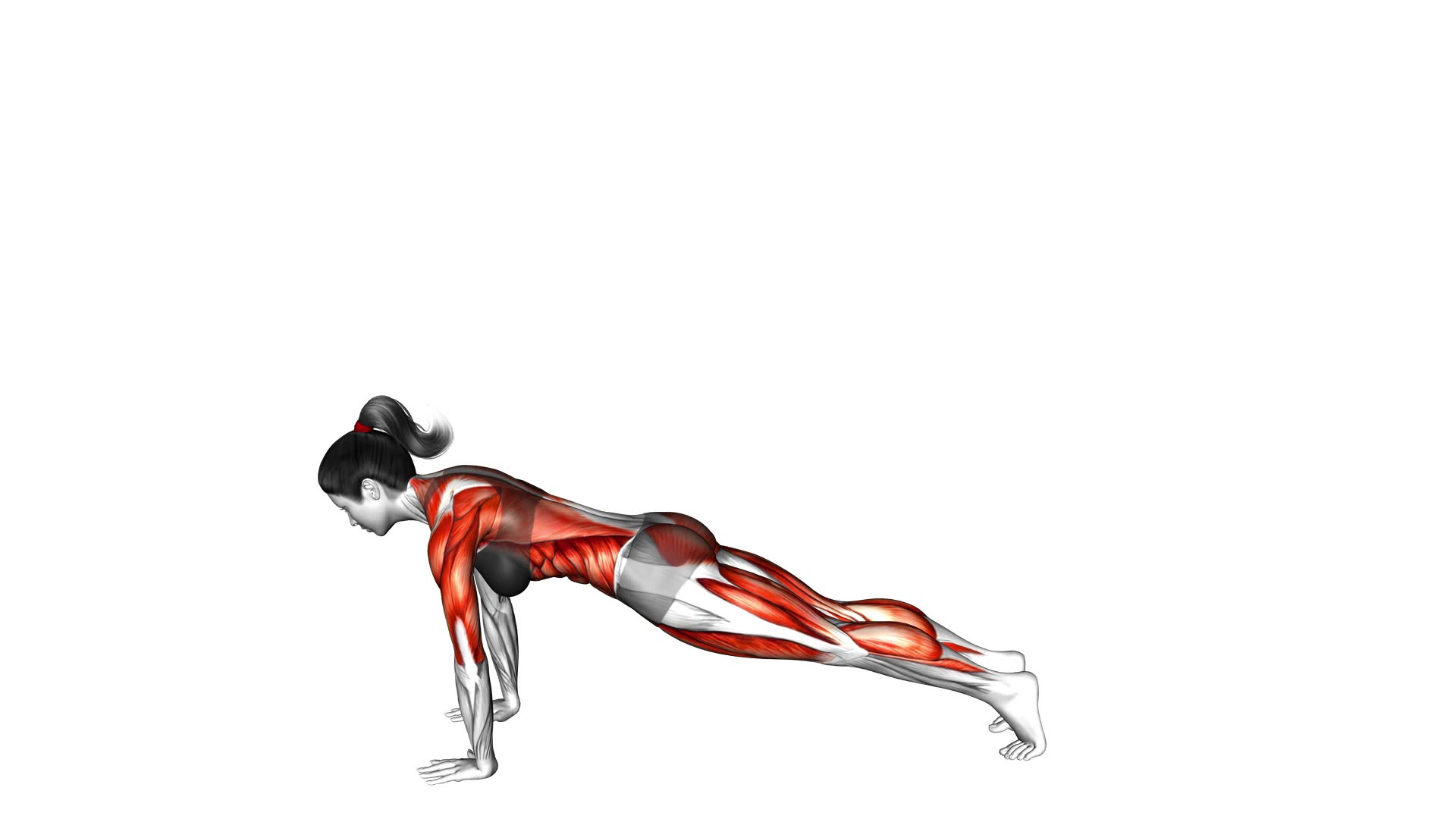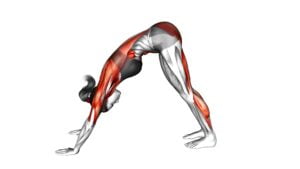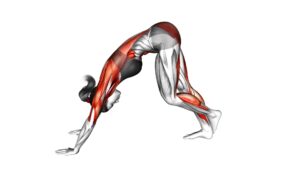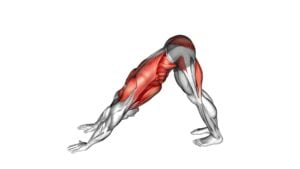Downward Dog Leg Raise (female) – Video Exercise Guide & Tips

Get ready to strengthen and tone your legs with the downward dog leg raise.
Watch This Exercise Video
This video exercise guide will show you the proper form and technique to maximize your results.
Avoid common mistakes and try variations and modifications to challenge yourself.
With these tips, you'll be on your way to a stronger lower body.
So grab your mat and get ready to feel the burn!
Key Takeaways
- Downward Dog Leg Raise strengthens core muscles in the abdomen, lower back, and pelvis.
- Proper form and technique, such as maintaining pelvic alignment and engaging the core, are important for a stable base and to prevent strain on the lower back.
- Breathing deeply and engaging the core during the exercise improves control, stability, and performance.
- Common mistakes to avoid include maintaining proper form, avoiding sagging hips, and controlling the movement without using momentum.
Benefits of Downward Dog Leg Raise
One major benefit of the Downward Dog Leg Raise exercise is that it strengthens your core. This exercise targets the muscles in your abdomen, lower back, and pelvis, helping to improve overall stability and balance. By engaging your core muscles, you not only develop a strong and toned midsection, but you also support your spine and improve your posture.
In addition to strengthening your core, the Downward Dog Leg Raise also helps to improve flexibility. As you lift your leg up and back, you stretch the muscles in your hamstrings, calves, and hips. This can help to increase your range of motion, making everyday activities easier and reducing the risk of injury.
To get the most out of this exercise, make sure to engage your core muscles throughout the movement. Keep your back flat and your hips level as you raise your leg. Focus on breathing deeply and maintaining good form. As you continue to practice this exercise, you'll notice increased strength and flexibility in your core and lower body.
Incorporating the Downward Dog Leg Raise into your fitness routine can provide numerous benefits, including improved flexibility and a stronger core. So, don't wait any longer – start working on your core strength and flexibility today!
Proper Form and Technique
To perform the Downward Dog Leg Raise with proper form and technique, it's important to focus on pelvic alignment during the exercise. Keep your hips level and square to the ground to ensure a stable base and prevent any strain on your lower back.
Additionally, remember to engage your core and breathe deeply throughout the movement to maximize the effectiveness of the exercise and maintain control.
Pelvic Alignment During Exercise
Maintain proper pelvic alignment during exercises by engaging your core and keeping your hips in line with your spine. Pelvic stability is crucial for proper form and technique during workouts.
When your pelvis is aligned correctly, it helps distribute the load evenly and prevents excessive stress on certain muscles or joints. By engaging your core muscles, you provide stability to your pelvis, ensuring that it stays in the right position. This not only improves your overall posture but also allows for efficient muscle activation.
When your pelvis is properly aligned, the muscles surrounding it can work optimally, leading to better strength, balance, and coordination. So remember, focus on engaging your core and maintaining proper pelvic alignment to enhance the effectiveness of your exercises and reduce the risk of injury.
Breathing and Core Engagement
Engage your core and focus on proper breathing techniques to optimize your form and technique during the Downward Dog Leg Raise exercise.
Breathing plays a crucial role in any exercise, as it helps you maintain control and stability throughout the movement. When performing the Downward Dog Leg Raise, inhale deeply through your nose as you prepare to lift your leg, and exhale forcefully through your mouth as you raise your leg towards the ceiling.
This controlled breathing pattern helps activate your core muscles, providing stability and support to your body. As you exhale, imagine drawing your navel towards your spine, engaging your deep abdominal muscles and strengthening your core.
Remember, proper breathing and core activation won't only improve your performance but also reduce the risk of injury.
Common Mistakes to Avoid
To ensure you get the most out of your Downward Dog Leg Raise, it's important to avoid common mistakes.
First, make sure you're maintaining proper form throughout the exercise, as demonstrated in the video. This will help you target the right muscles and prevent injury.
Additionally, follow the injury prevention tips provided to ensure a safe and effective workout.
Proper Form Demonstration
To demonstrate proper form and avoid common mistakes when performing the Downward Dog Leg Raise exercise, you should focus on maintaining a straight line from your hands to your hips. This will help ensure that you're engaging the correct muscles and getting the most out of the exercise.
Here are some tips to help you perform the exercise with proper form:
- Breath control: Remember to inhale as you raise your leg and exhale as you lower it. This will help you maintain control and stability throughout the movement.
- Muscle activation: Focus on activating your core muscles and glutes as you raise your leg. This will help you maintain stability and prevent your hips from rotating.
- Avoid sagging hips: Keep your hips level and avoid letting them sag towards the ground. This will help you maintain a straight line from your hands to your hips.
- Avoid rounding the back: Keep your spine neutral and avoid rounding your back. This will help you maintain proper alignment and prevent strain on your lower back.
- Control the movement: Slowly raise and lower your leg with control. Avoid swinging your leg or using momentum to perform the movement.
Injury Prevention Tips
To prevent injuries and ensure a safe workout, focus on maintaining proper form and avoiding common mistakes when performing the Downward Dog Leg Raise exercise. This won't only help you maximize the benefits of the exercise but also minimize the risk of strain or injury.
One common mistake to avoid is lifting your leg too high, as this can put excessive strain on your lower back. Instead, focus on a controlled and controlled movement, keeping your core engaged and your back neutral.
Another important aspect of injury prevention is recovery techniques and stretching exercises. After completing your workout, make sure to incorporate stretching exercises to release tension and improve flexibility.
Additionally, don't forget to give your body enough time to recover between workouts to prevent overuse injuries.
Variations and Modifications
Try different variations and modifications of the Downward Dog Leg Raise exercise to challenge yourself and target specific muscle groups. Here are some options to consider:
- Single Leg Downward Dog: Lift one leg off the ground and hold the position while performing the leg raise with the other leg. This variation increases the intensity and engages the core and glutes more.
- Resistance Band Leg Raise: Attach a resistance band around your ankles and perform the leg raise while maintaining tension on the band. This adds resistance to the exercise, making it more challenging for your leg muscles.
- Medicine Ball Leg Raise: Place a medicine ball between your feet and squeeze it as you raise your legs. This variation works your inner thighs and adds an extra challenge to your lower body.
- Pulse Leg Raise: Instead of raising your leg all the way up, perform small pulses at the top of the movement. This increases the time under tension and intensifies the exercise.
- Elevated Leg Raise: Place your hands on an elevated surface, such as a bench or step, and perform the leg raise from that position. This variation increases the range of motion and engages your upper body more.
Remember to choose a variation that suits your fitness level and goals. Don't be afraid to challenge yourself and switch things up to keep your workouts interesting and effective.
Tips for Maximizing Results
To maximize your results, focus on maintaining proper form and incorporating progressive overload into your Downward Dog Leg Raise routine. Proper form ensures that you're targeting the right muscles and avoiding any potential injuries. When performing the exercise, make sure your hands are shoulder-width apart and your feet are hip-width apart. Keep your core engaged and your hips lifted as you raise one leg at a time. This will help you get the most out of each repetition.
In addition to proper form, incorporating progressive overload is essential for maximizing your results. Progressive overload means gradually increasing the intensity or difficulty of your workouts over time. You can do this by adding ankle weights or resistance bands to your leg raises, or by increasing the number of repetitions or sets. This constant challenge will help you build strength and endurance, leading to greater results.
Staying motivated is also crucial for achieving your fitness goals. Set realistic and achievable goals for yourself, and track your progress to stay motivated. Celebrate small milestones along the way to keep yourself motivated and engaged. Additionally, remember to give yourself adequate rest and recovery time. Rest allows your muscles to repair and grow stronger, preventing burnout and reducing the risk of injury.
Sample Workout Routine
To maximize your results with the Downward Dog Leg Raise, it's important to follow a sample workout routine that targets the muscles involved and gradually increases in intensity. By incorporating this routine into your fitness regimen, you'll be able to improve your workout intensity and effectively manage your time.
Here is a sample workout routine to help you get started:
- Warm up: Begin with a five-minute warm-up, such as light jogging or jumping jacks, to prepare your body for exercise.
- Downward Dog Leg Raise: Perform three sets of 10-12 repetitions of the exercise, focusing on maintaining proper form and engaging your core and glutes.
- Rest: Take a 30-second rest between sets to allow your muscles to recover.
- Active recovery: Incorporate active recovery exercises, such as walking or stretching, between sets to keep your heart rate elevated and prevent muscle stiffness.
- Cool down: Finish your workout with a five-minute cool down, including stretching exercises to promote flexibility and prevent muscle soreness.
Remember to listen to your body and adjust the workout intensity based on your fitness level. As you progress, gradually increase the number of sets or repetitions to continue challenging your muscles. With proper time management and commitment to this sample workout routine, you'll soon see improvements in your strength and flexibility. Keep pushing yourself and enjoy the journey to a fitter, stronger you!
Frequently Asked Questions
Can Men Also Perform the Downward Dog Leg Raise Exercise?
Yes, men can also perform the downward dog leg raise exercise. It's a versatile exercise that can be modified to suit different fitness levels and body types.
If you find it challenging to perform the exercise in the traditional way, you can try modifying it by bending your knees or performing a modified plank position.
Alternatively, there are other exercises that target similar muscle groups, such as the plank leg raise or the bridge pose.
Keep pushing yourself and exploring different variations to find what works best for you.
How Many Sets and Repetitions Should I Do for the Downward Dog Leg Raise?
For the downward dog leg raise, a good starting point is to do 3 sets of 10 repetitions.
However, you can adjust the number of sets and reps based on your fitness level and goals.
Remember to focus on maintaining proper form and technique throughout the exercise.
Avoid common mistakes like lifting your leg too high or arching your back.
Consistency and gradually increasing the intensity will help you achieve the best results.
Keep pushing yourself and you'll see progress!
Can I Do the Downward Dog Leg Raise if I Have a Knee Injury?
Can I modify the downward dog leg raise for a knee injury?
If you're dealing with a knee injury, it's important to listen to your body and avoid exercises that could worsen the condition.
Instead of the downward dog leg raise, you can try alternative exercises that are less intense on the knees, such as seated leg extensions or standing hamstring curls.
Remember to consult with a healthcare professional or a certified trainer for personalized modifications and recommendations.
Will the Downward Dog Leg Raise Help in Reducing Lower Back Pain?
The downward dog leg raise is a great exercise for reducing lower back pain. By engaging your core and stretching your hamstrings, it helps to improve overall flexibility and strength.
The movement also helps to open up the hips and relieve tension in the lower back. Whether you're a beginner or advanced, there are modifications and variations of this exercise to suit your fitness level.
Can I Incorporate Weights or Resistance Bands to Make the Downward Dog Leg Raise More Challenging?
To make the Downward Dog Leg Raise more challenging, you can definitely incorporate weights or resistance bands. By adding resistance, you'll engage more muscles and increase the intensity of the exercise.
Start with light weights or a light resistance band and gradually increase as you get stronger. Remember to maintain proper form and control throughout the movement.
This modification won't only make the exercise more challenging but also help you build strength and tone your muscles effectively.
Keep pushing yourself!
Conclusion
Incorporating the downward dog leg raise into your workout routine can provide numerous benefits. This exercise helps to strengthen your core, improve flexibility, and tone your legs.
To maximize the results of this exercise, it is important to maintain proper form and technique. Avoiding common mistakes is also crucial.
Additionally, exploring variations and modifications of the downward dog leg raise can add variety to your workout and target different muscle groups.
Remember to stay consistent and dedicated to your workouts in order to see progress over time.
So, get ready to elevate your fitness journey with the downward dog leg raise!

Author
Years ago, the spark of my life’s passion ignited in my mind the moment I stepped into the local gym for the first time. The inaugural bead of perspiration, the initial endeavor, the very first surge of endorphins, and a sense of pride that washed over me post-workout marked the beginning of my deep-seated interest in strength sports, fitness, and sports nutrition. This very curiosity blossomed rapidly into a profound fascination, propelling me to earn a Master’s degree in Physical Education from the Academy of Physical Education in Krakow, followed by a Sports Manager diploma from the Jagiellonian University. My journey of growth led me to gain more specialized qualifications, such as being a certified personal trainer with a focus on sports dietetics, a lifeguard, and an instructor for wellness and corrective gymnastics. Theoretical knowledge paired seamlessly with practical experience, reinforcing my belief that the transformation of individuals under my guidance was also a reflection of my personal growth. This belief holds true even today. Each day, I strive to push the boundaries and explore new realms. These realms gently elevate me to greater heights. The unique combination of passion for my field and the continuous quest for growth fuels my drive to break new ground.



